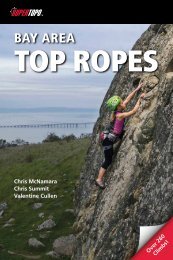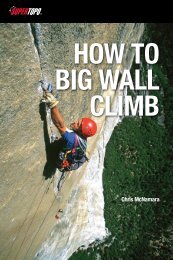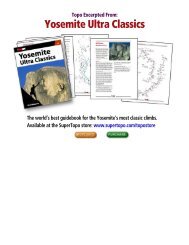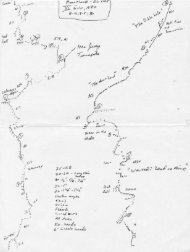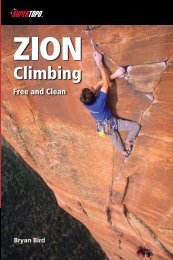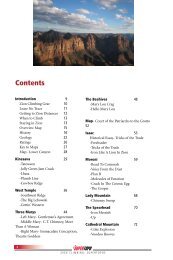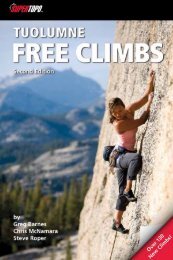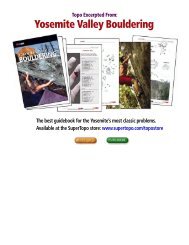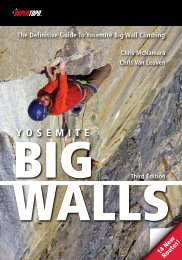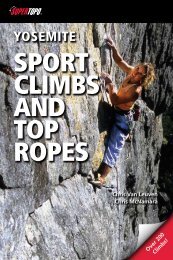You also want an ePaper? Increase the reach of your titles
YUMPU automatically turns print PDFs into web optimized ePapers that Google loves.
S U P E R T O P O S
Warning!<br />
Climbing is an inherently dangerous sport in which severe injuries or death may occur. Relying on<br />
the information in this book may increase the danger.<br />
When climbing you can only rely on your skill, training, experience and conditioning. If you have<br />
any doubts as to your ability to safely climb any route in this guide, do not try it.<br />
This book is neither a professional climbing instructor nor a substitute for one. It is not an<br />
instructional book. Do not use it as one. It contains information that is nothing more than a<br />
compilation of opinions about climbing the Big Walls in Yosemite Valley. Those opinions are<br />
neither facts nor promises. Treat the information as one man’s opinions and nothing more. Do not<br />
substitute these opinions for your own common sense and experience.<br />
Assumption of Risk<br />
There may be errors in this book resulting from the inadvertent mistakes of the author and/or the<br />
people with whom he consulted. The information was gathered from a variety of sources, which<br />
may not have been independently verified. Those who provided the information may have made<br />
mistakes in their descriptions. The author may have made mistakes in his conveyance of the<br />
information in this book. He cannot, therefore, guarantee the correctness of any of the<br />
information contained in the book. This book was published by the author. No independent<br />
publisher checked the contents. The topographical maps, the photo-diagrams, the difficulty ratings,<br />
the protection ratings, the approach and/or descending information, the suggestions about<br />
equipment and other matters may be incorrect or misleading. Fixed protection may not be where<br />
indicated, may be absent, or may be unreliable. You must keep in mind that the information in<br />
this book may be erroneous and use your own judgement when choosing, approaching, climbing<br />
or descending from a route described in this book.<br />
DO NOT USE THIS BOOK UNLESS YOU ASSUME THE RISK OF ITS ERRORS OF REPORTAGE OR OF JUDGMENT<br />
AND OF ITS OTHER DEFECTS.<br />
Disclaimer of Warranties<br />
THE AUTHOR AND PUBLISHER WARNS THAT THIS BOOK CONTAINS ONLY THE AUTHOR’S OPINION ON<br />
THE SUBJECTS DISCUSSED. HE MAKE NO OTHER WARRANTIES, EXPRESS OR IMPLIED, OF<br />
MERCHANTABILITY, FITNESS FOR PURPOSE, OR OTHERWISE, AND IN ANY EVENT, HIS LIABILITY FOR<br />
BREACH OF ANY WARRANTY OR CONTRACT WITH RESPECT TO THE CONTENT OF THIS BOOK IS LIMITED<br />
TO THE PURCHASE PRICE OF THE BOOK. HE FURTHER LIMITS TO SUCH PURCHASE PRICE HIS LIABILITY<br />
ON ACCOUNT OF ANY KIND OF NEGLIGENT BEHAVIOR WHATSOEVER ON HIS PART WITH RESPECT TO THE<br />
CONTENTS OF THIS BOOK.<br />
COPYRIGHT © 2000 SUPERTOPO LLC. ALL RIGHTS RESERVED. DUPLICATION PROHIBITED.
PREFACE<br />
SuperTopo Mission<br />
• Help climbers ascend and descend routes quickly,<br />
efficiently, and safely by creating the most accurate<br />
and informative climbing topos ever published.<br />
• Advocate routes that follow natural lines while<br />
discouraging routes that are heavily bolted,<br />
enhanced or unsustainable.<br />
• Capture the mystery, adventure and humor of<br />
climbing by publishing the histories, anecdotes and<br />
outrageous stories of each route.<br />
• Promote hammerless climbing by publishing the<br />
most up to date rack info as well as hammerless<br />
ratings for each pitch.<br />
• Stress the importance of climbing in good style<br />
and promote stewardship of the environment.<br />
Visit SuperTopo.com<br />
Throughout this book you’ll notice,“For the latest route<br />
information, visit www.supertopo.com.” Our website<br />
is the definitive resource for the latest SuperTopos—<br />
including expanded and updated detail on every route<br />
in this book and many more routes. The SuperTopo<br />
website includes:<br />
• The latest info on every route in this book and<br />
many more<br />
• Color SuperTopos and color photos, formatted for<br />
printing on your inkjet or laser printer<br />
• Detailed pitch-by-pitch climbing info and photos<br />
for many climbs<br />
• Additional SuperTopo products such as our<br />
Climber’s Dream-trip Series—selections of<br />
climbs in Yosemite and other great climbing areas<br />
in North America. Examples include:<br />
The Road to the Nose A<br />
series of climbs to help you<br />
prepare for your first<br />
attempt on The Nose.<br />
SuperTopos are included<br />
for each route as well as an<br />
overview written by Chris<br />
McNamara offering<br />
guidance on how to<br />
prepare for The Nose. This<br />
package also includes gear<br />
recommendations and<br />
contact information for<br />
climbing guides and<br />
instructional courses in<br />
Yosemite.<br />
In the Footsteps of Legends<br />
Repeat the great climbs of<br />
Yosemite heroes such as<br />
Warren Harding, Tom Frost, Royal Robbins and<br />
more by following the SuperTopos in this series.<br />
In addition to expanded climbing beta you’ll also<br />
find enhanced route histories in this series.<br />
Ultimate Roadtrip Series A series of roadtrip<br />
itineraries including all the required SuperTopos<br />
and beta to introduce you to the best climbs as<br />
you visit the most awesome climbing areas.<br />
A lot of information on our website is available<br />
completely free of charge—including free<br />
SuperTopos on the most classic Yosemite routes.<br />
Check it out. We hope you’ll also take time to check<br />
out our download-able SuperTopo products, such as<br />
the Climber’s Dream-trips above, available for<br />
online purchase.<br />
Visit www.supertopo.com before your next climb.<br />
The best and most current info on the route you are<br />
planning to climb is probably waiting for you there.<br />
Heck, visit us right now.<br />
FOR CURRENT ROUTE INFORMATION, VISIT SUPERTOPO.COM
Understanding the maps<br />
Topo symbols<br />
Right facing<br />
corner<br />
Ledge<br />
Bolt or<br />
rivet<br />
Left facing<br />
corner<br />
Straight in<br />
crack<br />
Groove<br />
Slab<br />
Belay<br />
station<br />
Pitch<br />
length<br />
1<br />
130'<br />
Hook<br />
placements<br />
Face<br />
climbing<br />
Pendulum<br />
or<br />
Chimney<br />
Optional<br />
belay<br />
Tree<br />
or<br />
Roof<br />
False<br />
belay<br />
Bush<br />
Topo abbreviations<br />
KB = Knifeblade piton<br />
LA = Lost Arrow piton<br />
ow = offwidth<br />
lb = lieback<br />
p = fixed piton<br />
Overview graphics<br />
Road<br />
Hooks<br />
The standard set of hooks includes: 1 each bat<br />
hook or talon, cliff hanger, pointed cliffhanger,<br />
grappling hook or fish hook.<br />
Bivouacs<br />
Bivies are rated as “great”, “good”, “ok” or “poor.”<br />
Route evolution<br />
Keep in mind when reading first ascent accounts<br />
that much of the routes may be drastically<br />
changed. For example, the Triple Cracks pitch on<br />
the Shield now takes large angles, not the 35 rurps<br />
placed on the first ascent.<br />
Bike path<br />
Park service trail<br />
Climber approach<br />
or descent trail<br />
Parking area<br />
FOR CURRENT ROUTE INFORMATION, VISIT SUPERTOPO.COM
Yosemite Valley<br />
COPYRIGHT © 2000 SUPERTOPO LLC. ALL RIGHTS RESERVED. DUPLICATION PROHIBITED.<br />
Legend<br />
Road<br />
Bike path<br />
Park service trail<br />
Climber approach<br />
or descent trail<br />
Parking area<br />
to Hwy 120,<br />
west entrance,<br />
Hwy 140<br />
to south<br />
entrance,<br />
Hwy 41<br />
one way<br />
Bridalveil Fall<br />
parking<br />
one way<br />
to Tamarack Flat<br />
Southwest<br />
Face<br />
path<br />
to falls<br />
chimney<br />
descent<br />
Leaning Tower<br />
standard<br />
approach<br />
El Capitan<br />
Meadow<br />
Cathedral Rocks<br />
El Capitan<br />
Southeast<br />
Face<br />
to Yosemite Falls Trail<br />
and Camp 4<br />
East Ledges<br />
descent<br />
Zodiac talus<br />
approach<br />
raps<br />
Manure Pile Buttress<br />
parking<br />
one way<br />
Merced<br />
River<br />
Camp 4<br />
N<br />
one way<br />
Yosemite<br />
Lodge<br />
Continued on<br />
next page
El Capitan<br />
Approach<br />
For all routes on El Cap it is<br />
recommended that you start<br />
on the main trail described<br />
here. There are other trails that<br />
may be more direct to your<br />
route, but they will also be<br />
more strenuous and covered<br />
with talus.<br />
From the main road at<br />
El Cap Meadow, pick up the<br />
distinct trail that starts 50 feet<br />
west of the sign directing<br />
drivers to Routes 120, 140 and<br />
41. Follow the trail to a large<br />
clearing. When facing the<br />
wall, walk at 10 o’clock and<br />
pick up the distinct climbers<br />
trail that eventually leads to a<br />
point 200 feet in front of the<br />
toe of the Southeast Buttress<br />
and the start of the Nose.<br />
From here, the trail diverges<br />
to skirt either the base of the<br />
Southeast Face or Southwest<br />
Face. It’s about a quarter mile<br />
and a 10- to 15-minute walk<br />
from the road to the toe of the<br />
Southeast Buttress and the<br />
start of the Nose. From there,<br />
it is an additional 20 to 30<br />
minutes to reach the start of<br />
Lurking Fear or Zodiac.<br />
Portaledge party on Belay 10 of Aurora. Photo by<br />
Greg Epperson.<br />
COPYRIGHT © 2000 SUPERTOPO LLC. ALL RIGHTS RESERVED. DUPLICATION PROHIBITED.
East Ledges Descent<br />
EL CAPITAN<br />
wild white dikes<br />
on black wall<br />
STEEP<br />
cross drainage, move<br />
down 40', then exit<br />
to shoulder<br />
WALL<br />
edge<br />
A<br />
4th<br />
150'<br />
A, B<br />
4th<br />
B<br />
135'<br />
100'<br />
B<br />
90'<br />
B<br />
120'<br />
or 5.5<br />
C<br />
155'<br />
C<br />
5.6 East<br />
Ledges route<br />
165' 100'<br />
200'<br />
165'<br />
A, B<br />
C<br />
Area overview<br />
55'<br />
150'<br />
Complete Yosemite Valley overview on pages 36–37<br />
to Yosemite Falls Trail<br />
and Camp 4<br />
B<br />
100'<br />
5.2<br />
to Tamarack Flat<br />
3rd<br />
Southwest<br />
Face<br />
El Capitan<br />
Southeast<br />
Face<br />
East Ledges<br />
descent<br />
Zodiac talus<br />
approach<br />
raps<br />
enlarged<br />
at right<br />
Manure Pile Buttress<br />
parking<br />
When trail meets<br />
drainage, cut across<br />
to trees and follow trail<br />
to Manure Pile buttress<br />
parking lot<br />
drainage<br />
standard<br />
approach<br />
one way<br />
El Capitan<br />
Meadow<br />
path<br />
to falls<br />
Cathedral Rocks<br />
FOR CURRENT ROUTE INFORMATION, VISIT SUPERTOPO.COM
National Park Service<br />
1 Lurking Fear<br />
2 Dihedral Wall<br />
3 Cosmos<br />
4 Excalibur<br />
5 Salathé Wall<br />
6 Flight of the Albatross<br />
7 The Shield<br />
8 Muir Wall<br />
9 Triple Direct<br />
10 The Nose<br />
COPYRIGHT © 2000 SUPERTOPO LLC. ALL RIGHTS RESERVED. DUPLICATION PROHIBITED.
to<br />
East<br />
Ledges<br />
raps<br />
Galen Rowell/Mountain Light<br />
A East Ledges descent<br />
10 The Nose<br />
11 Tribal Rite<br />
12 New Dawn<br />
13 Reticent Wall<br />
14 Wall of Early Morning Light<br />
15 Mescalito<br />
16 South Seas<br />
17 Pacific Ocean Wall<br />
18 Sea of Dreams<br />
19 North America Wall<br />
20 Wyoming Sheep Ranch<br />
21 Atlantic Ocean Wall<br />
22 Iron Hawk<br />
23 Native Son<br />
24 Aurora<br />
25 Tangerine Trip<br />
26 Lost in America<br />
27 Zenyatta Mondatta<br />
28 Shortest Straw<br />
29 Zodiac<br />
30 Lunar Eclipse<br />
31 Eagle’s Way<br />
FOR CURRENT ROUTE INFORMATION, VISIT SUPERTOPO.COM
The Nose<br />
VI 5.13+ or 5.9 C1 or 5.8 C2<br />
EL CAPITAN<br />
Long, sustained and flawless; the Nose may be the<br />
best rock climb in the world; it is certainly the best<br />
known. At 5.9 C1 this route is technically easy but<br />
don’t be fooled. The Nose, like all El Cap routes is huge<br />
exposed and terrifying.<br />
First ascent history<br />
After missing a chance to make the first ascent of<br />
Half Dome, Warren Harding knew there was only<br />
one other accomplishment that could surpass it—the<br />
first ascent of El Capitan. Because no technical rock<br />
climb of this scale had ever been attempted, Harding<br />
employed expedition tactics of using supplied camps<br />
linked by fixed ropes. In addition, the Park Service<br />
mandated that the climbers use fixed ropes so that a<br />
rescue would not be necessary. On July 4, 1957, six<br />
days after the first ascent of Half Dome, Harding and<br />
his team began their historic journey.<br />
After reaching Sickle Ledge in three days, the<br />
team pulled off two wild pendulums and faced the<br />
next obstacle, a series of 300-foot long, 2–3" wide<br />
cracks. Standard pitons that large did not exist, but<br />
Harding had come prepared. He had four enameled<br />
stove legs that Frank Tarver had scrounged from a<br />
Berkeley dump. Leapfrogging the 9" monsters up the<br />
continuously wide cracks, the team made it to<br />
within 100 feet of Dolt Tower before descending.<br />
The climb was a huge tourist attraction, and<br />
traffic became so tangled that the Park Service<br />
ordered a halt to the project until fall. Even under<br />
the best of circumstances climbers were viewed as a<br />
nuisance by the Park Service—“Somewhere between<br />
hippies and bears,” noted Wayne Merry, a member<br />
of Harding’s team. Despite the lack of warm feelings<br />
for the project, the Park Service lifted the ban as<br />
promised and Harding’s team pushed up to Dolt<br />
Tower before descending for the winter, leaving fixed<br />
ropes attached to the wall. Fixed ropes reduced the<br />
fright of being on such a colossal wall, but because<br />
they were made of manila and left swaying in the<br />
wind for months on end, the ropes presented a<br />
danger in themselves. Steve Roper describes a close<br />
call: “Wally Reed had just begun prusiking up a<br />
section of rope when suddenly he plummeted back<br />
onto a ledge. The rope had broken. Luckily the ledge<br />
was a fair-sized one and he didn’t roll off.”<br />
In May 1958, Harding<br />
and the team reached the Boot<br />
Flake, a feature that mysteriously<br />
floats on the wall with no visible means of attachment.<br />
Each pin placement caused the whole feature to groan<br />
and expand. On top of the boot, seeking the next crack<br />
system, Harding unleashed the wildest pendulum ever<br />
done, now renowned as the King Swing.<br />
By fall the route was pushed up to Camp IV, and<br />
both climbers and the Park Service wanted to wrap<br />
things up. Harding had been the leader from the<br />
start, and as problems arose and partners bailed, it<br />
was his determination that kept the project alive. Of<br />
the eight climbers who contributed to the first<br />
ascent, only Harding was involved for the duration.<br />
On November 1, 1958, the team, now consisting<br />
of Harding, Merry, Rich Calderwood and George<br />
Whitmore, prusiked to their high point at 1,900 feet<br />
and launched their summit campaign. The Great<br />
Roof, although appearing from the ground to be the<br />
crux of the route, was easily dispatched, and the<br />
climbers moved steadily up to Camp VI. At this<br />
point Calderwood suddenly dropped out, leaving<br />
Whitmore to move loads and Harding and Merry to<br />
swing leads up the spectacular upper dihedrals.<br />
After enduring a storm on November 10, they<br />
reached a small ledge 180 feet below the summit. Above<br />
them loomed a blank and overhanging wall. At 6 p.m.<br />
the next day Whitmore came up the fixed ropes, which<br />
now spanned 2,800 feet of the wall, and delivered a fresh<br />
supply of bolts to Harding. What followed was described<br />
by Steve Roper in Camp 4 as “the most famous single<br />
episode in Yosemite’s illustrious climbing history.”<br />
For 14 hours, from dusk till dawn, Harding<br />
endured the unimaginable pain of hand drilling 28<br />
bolts in a row by headlamp. At 6 a.m. he stood<br />
exhausted but triumphant on the summit, greeted by<br />
hordes of friends and media who created a huge<br />
commotion unlike that prompted by any previous<br />
climb. Scaling El Capitan had required 45 days of<br />
climbing over 18 months and had consumed 125 bolts.<br />
The triumph shook both the climbing and non-climbing<br />
worlds and would change big wall climbing forever.<br />
The term “impossible climb” would never again be<br />
used as easily. Within a few years the rush was on to<br />
climb in Yosemite.<br />
Aid<br />
A = aid using hammer<br />
C = hammerless aid<br />
Mandatory free<br />
A5/C5<br />
A4/C4<br />
A3/C3<br />
A2/C2<br />
Pitch<br />
1 2 3 4 5 6 7 8 9 10 11 12 13 14 15 16 17 18 19 20 21 22 23 24 25 26 27 28 29 30 31<br />
C<br />
A1/C1 C C C C C C C C C C C C C C C C C C C C C C C C C C C C<br />
5.8-5.9 • •<br />
≤5.7 • • • • • • • • •<br />
COPYRIGHT © 2000 SUPERTOPO LLC. ALL RIGHTS RESERVED. DUPLICATION PROHIBITED.
The Nose<br />
EL CAPITAN<br />
AS I HAMMERED IN THE<br />
LAST BOLT AND<br />
STAGGERED OVER THE RIM,<br />
IT WAS NOT AT ALL CLEAR<br />
TO ME WHO WAS<br />
CONQUEROR AND WHO<br />
WAS CONQUERED: I DO<br />
RECALL THAT EL CAP<br />
SEEMED TO BE IN MUCH<br />
BETTER CONDITION THAN<br />
I WAS.<br />
WARREN HARDING<br />
Other history<br />
In 1960, Royal Robbins, Tom Frost, Chuck Pratt and Joe Fitchen made the second<br />
ascent of the Nose. This significant ascent, the first continuous ascent of El Capitan,<br />
proved that an enormous wall could be climbed without siege tactics, and it<br />
paved the way for the bold big wall ascents of the ’60s. Jim Bridwell, John Long<br />
and Billy Westbay made the first one-day ascent of the Nose in 1975. Their 15-hour<br />
dash laid the groundwork for the speed climbing that would grip the valley in<br />
later years.<br />
In 1981, Ray Jardine, the inventor of Friends, launched the first major attempt<br />
to free climb the Nose. Just below El Cap Tower the possible free route traversed<br />
30 feet on what Jardine hoped would be 5.11 terrain. He found the moves were<br />
actually much harder, so he used a cold chisel and manufactured 5.11. Jardine’s<br />
motive was his vision of “Numero Uno,” a route up El Cap that was moderate<br />
and accessible to the masses.<br />
In 1993, Lynn Hill approached the climb with a much different philosophy.<br />
After Jardine, many top climbers had attempted to free climb the Nose, but none<br />
was able to unlock sequences on the Great Roof or the Changing Corners. On her<br />
first attempt in 1993, Hill freed every pitch to Camp VI including the Great Roof—<br />
an incredible feat still unrepeated on lead. A few pitches higher on the Changing<br />
Corners pitch, a fixed piton lodged in a crucial finger lock blocked the free ascent.<br />
Returning to the summit a few weeks later with Brooke Sandahl, Hill removed<br />
the offending piton and worked the extremely technical moves. It looked like it<br />
would go!<br />
Hill and Sandahl returned to the base and began their ground up free ascent.<br />
Hill climbed the Great Roof first try and moved to the crux Changing Corners<br />
pitch. Here she employed “a bizarre sequence of moves involving delicate smears,<br />
stems, back-stepping, laybacking, arm bars, pinching, palming, etc.” Again, she<br />
sent the pitch first try and after four days of spectacular free climbing, Hill and<br />
Sandahl stood on the summit. The Nose was free.<br />
It is hard to top one of the great free climbing achievements of all time, but<br />
the next year Hill herself found a way. Starting at 10 p.m. on a September<br />
evening, Hill spent the next 23 hours climbing every pitch free, making the first<br />
one-day free ascent of the Nose.<br />
Strategy<br />
The Nose requires a fast and light strategy. Although many parties climb the<br />
route in more than four days, hauling that much food and water is not pretty.<br />
The route has little mandatory free climbing, but it will be more enjoyable and go<br />
faster if you can free 5.10. The Nose is the most popular route on El Cap, so<br />
prepare to wait in line for two days at the base. Most parties spend the first day<br />
hiking loads to the base and fixing to Sickle Ledge. Fixing gives a head start but<br />
increases the logistics of the climb. If you aim to do the route in two nights, bivy at<br />
El Cap Tower and Camp V. If you are aiming for three nights, bivy on Dolt Tower,<br />
Camp IV and Camp VI. The ASCA and others have replaced almost all lead and<br />
belay bolts.<br />
Retreat/Storm<br />
The Nose is set up for easy bailing from the last pitch all the way to the ground. It is<br />
much easier to retreat from the route with 60m ropes. In a storm the upper part of<br />
the wall, especially Camp VI, receives lots of runoff. Many rescues and a few<br />
deaths have resulted from parties not being equipped with adequate storm gear.<br />
Reference: Sierra Club Bulletin, Vertical World of Yosemite, Camp 4, Defying Gravity, Fifty Classic Climbs of North America,<br />
Big Wall Climbing, Climbing in North America, Downward Bound, 1993 and 1994.<br />
FOR CURRENT ROUTE INFORMATION, VISIT SUPERTOPO.COM
The Nose continued<br />
VI 5.13+ or 5.9 C1 or 5.8 C2<br />
EL CAPITAN<br />
8 140'<br />
Rack<br />
nuts: 2 ea (offsets useful)<br />
micro nuts: 1-2 ea (offsets useful)<br />
cams: 3 ea .5-1"<br />
2-3 ea 1.5-3.5"<br />
1 ea 4.5"<br />
5.11c or 5.7 C1<br />
tension traverse<br />
5.9<br />
or C2<br />
.6- 2"<br />
5.10<br />
or C2<br />
90' 2<br />
Entering The Stovelegs<br />
A is the original route and the<br />
most popular. B and C are<br />
fast and good ways to pass<br />
slower parties.<br />
5.9 or C1<br />
Sickle Ledge<br />
OK bivy for 2<br />
3 100'<br />
rope eating<br />
flake!<br />
100' 4<br />
80' 6<br />
5.9 bulge<br />
or C1<br />
120' 5<br />
4th<br />
5.9 or C1<br />
Dolt Hole<br />
100' 7<br />
5.8 or C1<br />
5.12a<br />
Fix four 50m<br />
or three 60m<br />
ropes to ground.<br />
There are bolt<br />
stations every<br />
50m.<br />
A<br />
B<br />
belay<br />
takes .5-3"<br />
5.9 lb<br />
or C1<br />
C 5.10d or<br />
5.9 A0 var<br />
5.6<br />
loose<br />
four more 50m<br />
raps to ground<br />
The Stovelegs<br />
5.8<br />
hands 10b move<br />
90' 17 left or C1<br />
don’t go<br />
right up<br />
here!<br />
5.10c<br />
or C1<br />
.6-2"<br />
90'<br />
Eagle Ledge<br />
10a lb or C1<br />
.6-3"<br />
90'<br />
5.9 face<br />
5.11c fingers<br />
or C1<br />
5.9 fist<br />
or C1<br />
two short swings<br />
or one long swing by lowering<br />
about 15' below Boot<br />
10a ow<br />
or C1<br />
5.12a<br />
4.5"<br />
King<br />
Swing<br />
Jardine<br />
Traverse<br />
50'<br />
many 2-4.5"<br />
OK bivy for 1<br />
16 130'<br />
Boot<br />
Flake<br />
C1<br />
Texas Flake<br />
5.7<br />
13 100'<br />
100' 14<br />
5.10c hands<br />
or C1<br />
.75-3.5"<br />
15 110'<br />
5.8 chimney<br />
(easiest on<br />
west end)<br />
5.9 or C1 over<br />
chockstones<br />
5.9 or C1<br />
El Cap<br />
Tower<br />
plush bivy<br />
for 4-6<br />
Salathé<br />
5.11a<br />
130' 1<br />
5.10<br />
or C1+<br />
5.10d or C1<br />
.5- 3"<br />
5.11b or C1<br />
5.10c fingers<br />
or C1<br />
platform<br />
Approach: From El Cap Bridge<br />
walk west 1/8 mile to a trail<br />
that leads to the Southeast<br />
Buttress of El Cap. From here either<br />
follow A, the recommended route<br />
or B, the fast but exposed route.<br />
Dolt Tower<br />
bivy 2 comfy, 4 okay<br />
140' 11<br />
5.10c ow or C1<br />
4.5"<br />
5.10b fist<br />
or C1<br />
4"<br />
3.5"<br />
5.8 fist or C1<br />
3"<br />
belay<br />
10 130' takes 1-3"<br />
12 100' belay<br />
takes 1-3"<br />
5.8 or C1<br />
5.7<br />
squeeze<br />
From Dolt Tower do eight 50m raps<br />
to the ground on chain anchors.<br />
First three raps are within ten feet<br />
of the Stovelegs. The last five raps<br />
are out on the blank face east of<br />
the route.<br />
Pine<br />
Line<br />
5.7<br />
A<br />
5.5<br />
T O E O F S. E<br />
4th<br />
exposed<br />
4th<br />
B<br />
. B U T T R E S S<br />
loose<br />
5.8 or p<br />
C1 gully p<br />
5.9 lb<br />
2-4.5"<br />
1-3"<br />
9 70'<br />
5.10 ow or C1<br />
4.5"<br />
The Stovelegs<br />
8<br />
COPYRIGHT © 2000 SUPERTOPO LLC. ALL RIGHTS RESERVED. DUPLICATION PROHIBITED.
The Nose<br />
VI 5.13+ or 5.9 C1 or 5.8 C2<br />
EL CAPITAN<br />
80'<br />
23 110'<br />
5.11c or C1<br />
shuttle gear<br />
to tree<br />
120' 31<br />
5.5<br />
Great Roof<br />
5.13+<br />
or C1<br />
10a lb<br />
or C1<br />
5.7<br />
Pancake<br />
Flake<br />
22 120'<br />
5.12c boulder<br />
problem crux<br />
C1<br />
steep<br />
5.12a var.<br />
5.11b var.<br />
haul here<br />
for less drag<br />
1-3"<br />
28 100'<br />
5.8 hands<br />
or C1<br />
5.11d<br />
or C1<br />
70' 30<br />
5.10d or C1<br />
27 150'<br />
100' 20<br />
5.11c or C1<br />
1-3"<br />
p<br />
5.10a<br />
or C1<br />
rap<br />
route<br />
5.9<br />
or C1<br />
5.7<br />
Camp IV<br />
poor bivy for 2<br />
5.10a var.<br />
19 120'<br />
OK bivy<br />
for 1<br />
rap route<br />
(angle east, two<br />
raps to<br />
Dolt Tower)<br />
.5-2"<br />
21 110'<br />
5.7<br />
5.12 or<br />
5.10 A0 var.<br />
50m from<br />
50m to<br />
5.10b<br />
or C1<br />
19<br />
22<br />
60m from 22<br />
60m to<br />
optional belay<br />
.5-2"<br />
5.10d<br />
or C1<br />
18 120' belay<br />
takes .5-2"<br />
.75-2.5"<br />
Camp V<br />
sharp<br />
17 110' 24<br />
if retreating from<br />
between 17 and 18,<br />
rappel down<br />
Jardine Traverse<br />
fixed<br />
1-3"<br />
1-3"<br />
5.10c<br />
or C1<br />
5.10d lb or C1<br />
5.10d<br />
28<br />
alcove<br />
29 130'<br />
good bivy for 2<br />
best hauling<br />
many nuts<br />
good bivy 2<br />
5.7<br />
.75-2.5"<br />
5.11 AO<br />
var.<br />
Changing<br />
Corners<br />
Camp VI<br />
ok bivy for 2<br />
5.11b or C1+<br />
110' 25<br />
move<br />
right<br />
5.7<br />
or C1<br />
ok bivy<br />
for 1<br />
1-3"<br />
5.10d<br />
or C1<br />
5.7<br />
or C1<br />
ok bivy for 1<br />
5.12d<br />
or C1<br />
5.9 hands<br />
or C1<br />
5.13+<br />
or C1<br />
sharp edge<br />
cross at<br />
low bolt<br />
26 150'<br />
ok bivy for 1<br />
1.5-3"<br />
Glowering Spot<br />
3' x 3' ledge<br />
Keep<br />
Camp VI<br />
clean!<br />
23<br />
5.11a or<br />
C1+ awk.<br />
FOR CURRENT ROUTE INFORMATION, VISIT SUPERTOPO.COM
Wall Tips<br />
H2O Rations (per person per day)<br />
3 quarts: October–May<br />
4 quarts: May, June, September<br />
4+ quarts: July and August<br />
For carrying water, two-liter soda bottles work<br />
best. Two-quart Gatorade bottles also work. These<br />
bottles are sturdy on their own and wrapping<br />
them in duct tape is generally a waste of time and<br />
tape. To clip in the bottles, clove hitch a thin tie-off<br />
under the mouth of the bottle.<br />
Essentials<br />
Helmet The most crucial piece of gear on a big wall.<br />
Handy wipes To clean hands and face at end of<br />
the day.<br />
Small knife For cutting faded slings off fixed pieces.<br />
Gloves Use goat skin gardening gloves or<br />
standard leather gloves with the fingertips cut<br />
off, then reinforced with duct tape to keep<br />
seams from unraveling.<br />
Poop tube It’s the law. Sling some four-inch<br />
diameter PVC pipe and put screw lids on both<br />
ends. Standard four-inch triple wall drainpipe is<br />
a lighter and far less expensive alternative to<br />
PVC. It’s plenty bomber, cuts easily, and accepts<br />
standard PVC fittings. Go in a paper bag, then<br />
drop it in the “vault” with a little kitty litter or<br />
lime to mediate the odor.<br />
Shoes Most wall shoes made by climbing shoe<br />
companies are good; but realize that even the<br />
most durable shoes will get thrashed on a wall.<br />
The cheaper alternative is to buy used hiking<br />
boots. A liberal coating of Seam Grip on the<br />
seams and rand of your wall shoes will make<br />
them last much longer.<br />
GriGri<br />
Waulhauler<br />
Stuff sacks with clip-in loops<br />
Duct tape It holds the world together.<br />
Leeper cam hooks Save time and the rock; once<br />
you get over the initial fear of using them, you<br />
will wonder how you ever climbed without them.<br />
Bolt Kit<br />
Used for replacing bad anchor bolts or broken<br />
lead bolts. In general, you do not need a bolt kit<br />
on hammerless routes. Machine heads are no<br />
longer recommended for rivets because they are<br />
difficult to place properly; thus, they become<br />
unreliable on future ascents. They are also<br />
impossible to replace. After heads have rusted,<br />
they need to be chopped, and subsequently, new<br />
holes have to be drilled. The standard rivet in<br />
Yosemite is either the Rawl Drive or Rawl Spike<br />
¼" by one inch.<br />
Equipment list<br />
Bolt bag (or use chalk bag or stuff sack), hand<br />
drill, blow tube, test-tube brush (used to clean<br />
holes), crescent wrench, ¼" x 1¼" Rawl Drive<br />
bolts or Rawl Spike bolts, ⅜" x 2¼" stainless<br />
Rawl bolts (a.k.a five piece), or stainless Fixé<br />
bolts, ¼" and ⅜" drill bits.<br />
Note: Each SDS bit is generally good for<br />
8–15 holes.<br />
COPYRIGHT © 2000 SUPERTOPO LLC. ALL RIGHTS RESERVED. DUPLICATION PROHIBITED.
APPENDIX<br />
Big Wall Cuisine<br />
Breakfast<br />
Canned fruit (peaches, pineapple, fruit<br />
cocktail); applesauce; mandarin oranges;<br />
granola with instant coffee and dried milk;<br />
danishes; Fig Newtons; Pop Tarts.<br />
Lunch/Snacks<br />
Candy bars (that don’t melt); granola bars;<br />
bagels, plain with cream cheese or with PB&J;<br />
energy bars; “Power Putty” made from peanut<br />
butter, raisins, granola, honey, flour (just a little<br />
to eliminate stickiness); beef jerky; cheese (precut<br />
and put in zip lock bag); nuts; trail mix;<br />
dried fruit; Jolly Ranchers (if you are out of<br />
food you will love these); chocolate covered<br />
espresso beans.<br />
Dinner<br />
Pudding cups; smoked oysters or salmon on<br />
crackers; “Schippoopi Sandwich” built on a bagel<br />
with ground pepper, cucumber, bell pepper, red<br />
onion, Grey Poupon (from deli) and hot sauce<br />
(from Taco Bell); canned food such as ravioli,<br />
spaghetti, chili and hearty canned soups. Bread,<br />
bagels and tortillas make cold canned food a little<br />
more palatable. Tupperware is crucial to keeping<br />
soft foods from getting squashed.<br />
FOR CURRENT ROUTE INFORMATION, VISIT SUPERTOPO.COM
Selected Yosemite<br />
Reading List<br />
There are hundreds of books to read on Yosemite big walls. What follows<br />
is a partial selection of sources I have found especially useful.<br />
Ament, Pat, 1992. Royal Robbins: Spirit of the<br />
Age. Adventure’s Meaning Press, Lincoln,<br />
Nebraska.<br />
American Alpine Journal, Golden, Colorado<br />
(americanalpineclub.org).<br />
Arce, Gary, 1996. Defying Gravity: High<br />
Adventure on Yosemite’s Walls. Wilderness Press,<br />
Berkeley, California.<br />
Climbing Magazine, Carbondale, Colorado.<br />
(climbing.com).<br />
Duane, Daniel, 1994. Lighting Out: A Vision of<br />
California and the Mountains. Graywolf Press,<br />
Saint Paul, Minnesota.<br />
Duane, Daniel, 1998. Looking for Mo.<br />
Washington Square Press, New York.<br />
Harding, Warren, 1975. Downward Bound—A<br />
Mad Guide to Rock Climbing. Menasha Ridge<br />
Press, Prentice Hall, Englewood Cliffs, NJ.<br />
Jones, Chris, 1976. Climbing in North America.<br />
University of California Press, Berkeley,<br />
California.<br />
Piana, Paul, 1998. Big Walls: Breakthroughs on<br />
the Free-Climbing Frontier. Sierra Club Books,<br />
San Francisco, California.<br />
Rock and Ice, Boulder, Colorado<br />
(rockandice.com).<br />
Roper, Steve, 1994. Camp 4: Recollections of a<br />
Yosemite Rockclimber. The Mountaineers,<br />
Seattle, Washington.<br />
Roper, Steve and Allen Steck, 1979. Fifty Classic<br />
Climbs of North America. Sierra Club Books,<br />
San Francisco, California.<br />
Roper, Steve and Allen Steck, 1999. Ascent: The<br />
Climbing Experience in Word and Image.<br />
American Alpine Club Press, Golden, Colorado.<br />
Roper, Steve, 1971. Climber’s Guide to Yosemite<br />
Valley. Sierra Club Books, San Francisco,<br />
California.<br />
Rowell, Galen, 1974. Vertical World of Yosemite.<br />
Wilderness Press, Berkeley, California.<br />
Scott, Doug, 1974. Big Wall Climbing. Oxford<br />
University Press, New York.<br />
Meyers, George, 1979. Yosemite Climber.<br />
Diadem Books/Robbins Mountain Letters,<br />
Modesto, California.<br />
COPYRIGHT © 2000 SUPERTOPO LLC. ALL RIGHTS RESERVED. DUPLICATION PROHIBITED.
APPENDIX<br />
About the Author<br />
Chris McNamara is addicted to El Capitan. He is one of the bestknown<br />
climbers on the Yosemite circuit and is the winner of the<br />
1999 Bates Award from the American Alpine Club as the nation’s<br />
outstanding young climber/mountaineer. He is also the founder<br />
and president of the American Safe Climbing Association and a<br />
student at UC Berkeley.<br />
Chris’ first El Capitan ascent was at age 15. A year later he and<br />
his brother Morgan became the youngest team, at 16 and 13, ever<br />
to climb El Cap. By the year 2000, at age 21, Chris had logged<br />
more than 54 ascents of El Cap, plus trips to Norway, Baffin Island<br />
and Ecuador. Climbing magazine once computed that 3 percent<br />
of Chris’ life on earth had been spent on the face of El Cap. His<br />
climbs include the first one-day ascents of Lurking Fear (solo),<br />
Dihedral Wall, Grape Race, Re-Animator and Muir Wall. He made<br />
the first clean ascent of the North America Wall<br />
and holds speed records on The Shield, Zodiac<br />
and Wet Denim Daydream. Chris has put up<br />
first ascents on Half Dome and in Zion, as well<br />
as doing the first Girdle Traverse of El Cap, a<br />
route that took five days, 75 pitches and 14,000<br />
feet of climbing.<br />
Chris founded the ASCA in 1997 during a<br />
year he took off between high school and college.<br />
The non-profit group has replaced more than<br />
1,500 anchor bolts on routes in Yosemite,<br />
Zion, and other climbing areas. Chris has<br />
replaced more than 450 himself. In addition<br />
to running the ASCA, Chris serves on the<br />
board of directors of the Access Fund. He lives<br />
in Berkeley, California.<br />
Mac proves no sleep, no steep: Recharging for another push up El Cap.<br />
Photo by Mike Ousley.<br />
FOR CURRENT ROUTE INFORMATION, VISIT SUPERTOPO.COM




